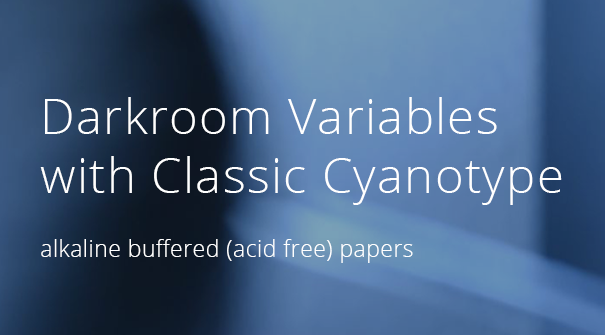
I used only acid free papers for quite a long time, before I started buying Arches Platine, a pure cotton rag with no alkaline reserve that gives me wonderful results with blue and turquoise shades.
Acid free papers such as watercolor papers often give very dark blues, even darker than Arches Platine and they are much cheaper, but they tend to bleach out when printing in cyanotype unless you adopt some countermeasures.
You have two ways to do so:
- pre acidify your sheets of paper before using them for printing
- compensate for the alkaline buffer when developing and washing your print.
I never pre acidify my paper because I don’t want to spend time working twice on a sheet of paper, but it might be the best practice, in fact if you pre acidify you end up printing with a neutral paper and this makes things good and easy.
If you coat your buffered paper the way it comes and print on it when the emulsion has dried, let’s say after one hour or so, you can perfectly compensate for the alkaline buffer when you develop and wash your paper immediately after printing.
In my tests I found that the alkaline buffer of Canson XL Aquarelle (or Watercolor, name depends on what market it is sold) can be perfectly compensated using 0,3 g/l of sulfamic acid put in all the dev. and washing baths, for at least 15 minutes, but 20 minutes are better for a complete wash.
Before Canson, I also used other buffered papers such as Fabriano Accademia and Caballo 109, and I always compensated for their alkaline buffer during wash.
Sulfamic acid has good properties when used with paper because it doesn’t interact badly with the paper itself and has no smelling fumes (unlike chloridric acid that I used when I began printing). But sulfamic acid is not super soluble so you need to warm up some water, up to 60-70 degrees Celsius (140-160 F), and then pour it on your acid crystals inside a capable container, then stir for a few minutes until complete dissolution.
I make a rough 10% solution (not exact in chemical practice) using 90 g of sulfamic acid crystals and 900 ml of water (0,9 liter).
When developing and washing the print that you have made on Canson XL Aquarelle (Watercolor) you need to put 3 ml of the sulfamic acid solution you have previously prepared per each liter of water you put in your trays.
For 20×30 cm (8×12 inches ca.) prints on Canson and classic cyanotype my 3 small trays are configured this way:
- 2 liters of water with 3 ml/l (in 10% solution) sulfamic acid, constantly rocking by hand for 1 minute (there is a lot of wash off).
- 2 liters of water with 3 ml/l (in 10% solution) sulfamic acid, rocking by hand for 4 minutes.
- 2 liters of water with 3 ml/l (in 10% solution) sulfamic acid, rocking (but less) by hand for 15 minutes.
You need to change the water in the first tray for each print (it gets very dirty) and you can use the water inside the second and third tray (with two liters of washing water each) for a maximum of three prints, this is because during washing the acid is slowly neutralized while compensating the alkaline buffer of the paper, so you need to have fresh water and acid to be always effective in washing the print and getting rid of the alkaline buffer.
If you want to use another type of acid, like citric acid (the worst option is chloridric acid), you’ll need to experiment with the quantities I suggested, since each acid has a different pH when diluted in water and so a different compensating ability.
If you want to use white vinegar you need to experiment too, you’ll need way more quantity.
Everything must be tested, defined and then kept consistent in your printing process, that is the base for a perfect digital negative.
This is an external resource for cyanotype printing of the Digital Negative video course. You can read more about it clicking HERE.